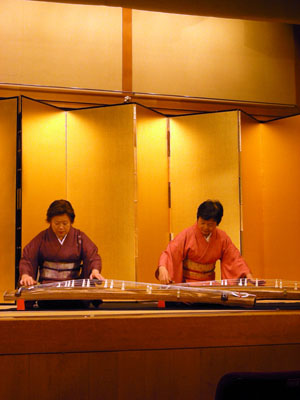Gion Corner is a theater where seven different forms of traditional Japanese folk arts are performed. While it is definitely designed for tourists (most of whom are Japanese), it is an excellent way to get an overview of some of the different art forms that make Japanese culture unique.
You get to observe a tea ceremony and the art of Japanese floral arrangement. There is a performance of Koto music and Gagaku music, Kyomai dance, a Kyogen comic play and a Bunraku puppet play. The performances are short and they only give you a brief overview of each art form. They are however, most certainly "authentic", being performed by people trained in these various arts.
Official English website
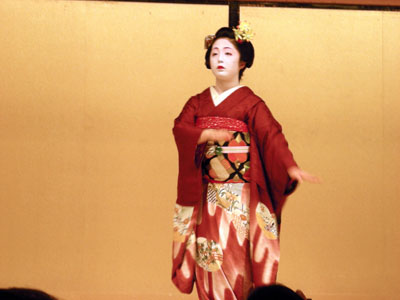 |
Left: Kyomai Dance, a style of dance that had its origins in Kyoto. Below Left: Japanese Koto music. The Koto is a 13 string instrument similar to a harp. Though it originated in China, it is considered the national instrument of Japan having been brought to the island in the 7th or 8th century. The melodies are quite beautiful. Below Right: The tradition of tasting tea was brought to Japan by Zen Buddhist monks during the 12th century. It was used to help stay alert during prolonged meditation. The tea ceremony gained its present form during the 15th century when a merchant named Sen No Rikyu codified his four fundamental qualities of a tea ceremony. |
|
|
|
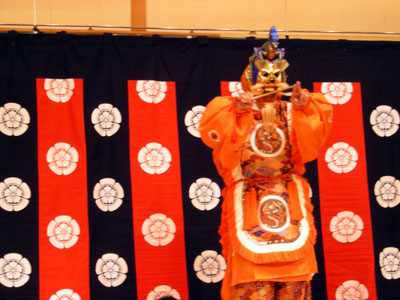 |
|
| Above & Left: Gagaku court music with Bugaku dance. Translated as "elegant music", it was brought to Japan from China and Korea and was performed exclusively in a court setting. To even be a Gagaku musician required belonging to a hereditary guild. The ensemble consisted of three wind instruments and three percussion instruments. For religious ceremonies, a performance could be accompanied by a dance known as bugaku thought to appease the gods. Quite frankly, the music sounds like stepping on a cat's tail to my ears but it is fascinating and the costumes associated with the dance are amazing. | |
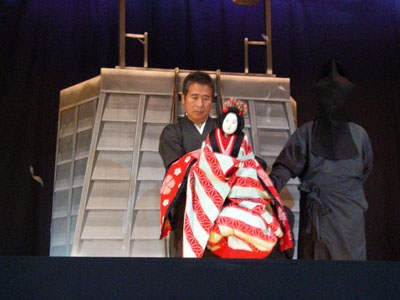 |
Left: Bunraku puppet play. More properly referred to as Ningyo joruri, this form of puppetry was developed in Osaka in the 17th century. Much more melodramatic than many other forms of entertainment, it became very popular among the Japanese merchant class. The puppets can range up to four feet tall and require two or more handlers. The performance was Datemusme Koi no Kiganoko (Oshichi at Fire Watch Tower). You can download a synopsis in pdf form here. I also took a brief digital camera video here. A good history of Bunraku is available on Wikipedia. |
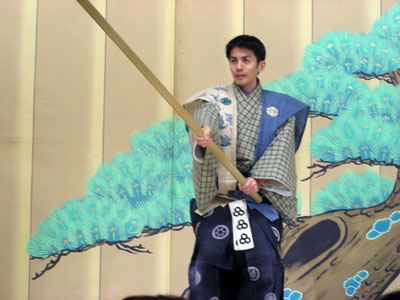 |
Left: Kyogen comic plays were performed as an interlude in the more dramatic Noh plays. Noh were very formalized musical dramas that could last all day. Kyogen were light, less sophisticated and written in the common language of the day. The evening's performance was Boshibari (The Cudgel Play) and was quite entertaining. |
| Daimyo, a gentleman of Japan, knows his two servants, Taro Kaja and Jiro Kaja, are stealing sake and determines to stop them. He tells Jiro that Taro is a thief who must be stopped. Jiro mentions how Taro prides himself on his skill with the quarter staff and how Taro could be tricked into being tied to the pole. When Taro enters, Daimyo entices him into a quarterstaff demonstration then binds his wrists to the pole. Jiro, imitating and mocking Taro’s performance, has his hands tied to his own pole. Daimyo, satisfied that his sake is now is safe, leaves on business. The servants go to the storehouse where they can at least smell the sake. Later that morning, they figure how to feed sake to each other despite their bonds and proceed to get fairly intoxicated. Daimyo returns and catches them. The servants run, and the master chases them. |
All photos on this page are originals by & copyrighted by Daren Willden, unless otherwise stated. All rights reserved.
